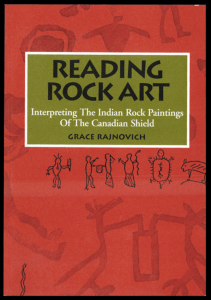
Published by Natural Heritage/Natural
History Inc. (2nd Edition 2002, 191 pages,
$21.95 Softcover)
ISBN 0-920474-72-1
Reviewed by Timothy Eaton
Have you ever discovered, while paddling the lakes and rivers of Quetico Superior Region, the picture writings of the Algonkian, Cree and Ojibway peoples only to be dumbstruck by their mysterious presence, their use of symbols and the stories they must tell? If so…
… Grace Rajnovich’s book Reading Rock Art will unravel the mysteries of these ancient writings for you. Her book offers new and plausible explanations to this awe-inspiring rock art found throughout the Quetico Superior Region.
She uses her 14 year study as a field archaeologist for the Ontario government to build upon previous studies of her peers, J.W. Powell, Kenneth Kidd and Selwyn Dewdney to present us a theory and explanation based on the Midewiwin Medicine Societies of the Algonkian peoples.
She points out that these rock paintings, with their bright red figures of people, animals, canoes, and bows-and-arrows common to the boreal forest life are also bound with the signs of medicine—drums, rattles, medicine bags and other items precious to the Indian healers (see Woodland Caribou Park story pictograph).
The Algonkian-speaking peoples relied on “medicine” and a deep spiritual connection to the manitous (pronounced muni-doe), the spirits who live in the rock. And “medicine” held a broad meaning; it could mean “mystery” or “power” and included not only the activity of curing with tonics from plants and minerals but also the receipt of powers from the manitous for healing, hunting and battle. “Rock art,” she concludes, “is a spectacular record of achievement painted by the seekers of medicine”.
Her book draws more attention to the astonishing legacy of the “picture writings” left by the Algonkian, Cree and Ojibway peoples; astonishing both in their antiquity and their ability to elicit an awe-inspiring sense of wonder with every new discovery.

